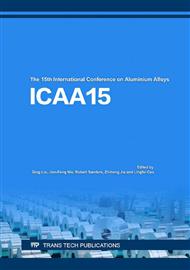[1]
T.Z. Wang, R.Z. Wu, J.H. Zhang, et al. Development of aluminum conductive materials, J. Materials Science & Technology. 22(06) (2014) 53-61.
Google Scholar
[2]
Z.Q. Huang, Application and Prospect of aluminum and aluminum alloy used in electric cable industry, J. Electic Wire &Cable. (2) (2013) 4-9.
Google Scholar
[3]
D. Chen, C.D. Li, X.D. Zhao, Research and application of aluminum alloy in the field of power transmission, J. Materials Review. (15) (2013) 145-148.
Google Scholar
[4]
R.Y. Zhang, X.Y. Zhao, M. Li, et al. Polarization and application of the new-type energy-saving conductors in transmission lines, Electric Power Construction. (06) (2012) 89-92.
Google Scholar
[5]
H.S. Ye, Application of moderate-strength all aluminum alloy conductor in transmission lines j. Electric Power Construction. 31(12) (2010) 14-19.
Google Scholar
[6]
S. Karabay, F.K. önder, An approach for analysis in refurbishment of existing conventional HV–ACSR transmission lines with AAAC J, Electric Power Systems Research. 72(2) (2004) 179-185.
DOI: 10.1016/j.epsr.2004.03.014
Google Scholar
[7]
S. Karabay, Influence of AlB 2 compound on elimination of incoherent precipitation in artificial aging of wires drawn from redraw rod extruded from billets cast of alloy AA-6101 by vertical direct chill casting J, Materials and Design. 29(7) (2007).
DOI: 10.1016/j.matdes.2007.06.004
Google Scholar
[8]
Z.X. Liu, Investigation on aging treatment of 6101 aluminium alloy D, Chang Sha: Central South University. (2013).
Google Scholar
[9]
Y. Sun, Effect of heat treatment on Microstructure and mechanical properties of 6082/6063 alloys D, Chang Sha: Central South University. (2012).
Google Scholar
[10]
H. Li, D.Z. Pan, Z.X. Wang, et al. Influence of T616 temper on tensile and intergranular corrosion properties of 6061 aluminum alloy J, Acta Metallurgica Sinica. (04) (2010) 494-499.
DOI: 10.3724/sp.j.1037.2010.00494
Google Scholar
[11]
J.A. Liu, Properties of natural aging and artificial aging of al-mg-si extrusion alloy J, The Chinese Journal of Nonferrous Metals. 8(1) (1998) 257-260.
Google Scholar
[12]
M.J. Wang, J.L. Wang, Study on Aging Treatments of 6063 Al-alloy J, Heat Treatment of Metals. (08) (1998) 26-43.
Google Scholar
[13]
G. Das, M. Das, S. Ghosh, et al. Effect of aging on mechanical properties of 6063 Al-alloy using instrumented ball indentation technique J, Materials Science & Engineering A. 527 (6) (2009)1590-1594.
DOI: 10.1016/j.msea.2009.10.037
Google Scholar
[14]
A. Gaber, M.A. Gaffar, M.S. Mostafa, et al. Precipitation kinetics of Al–1. 12 Mg2Si–0. 35 Si and Al–1. 07 Mg2Si–0. 33 Cu alloys J. Journal of Alloys and Compounds. 429(1-2) (2007) 167-175.
DOI: 10.1016/j.jallcom.2006.04.021
Google Scholar
[15]
Q.Q. Chen, Z.H. Zhao, Q.F. Zhu, et al. The effect of different strengthening mechanism on the hardness of 6201 aluminum alloy during heat treatment process J, Transactions of Materials and Heat Treatment. 2015, under review.
Google Scholar
[16]
X. Fang, M. Song, K. Li, et al. Precipitation sequence of an aged Al-Mg-Si alloy J. Journal of Mining and Metallurgy, Section B: Metallurgy. 46(2) (2010) 1895-(1902).
DOI: 10.2298/jmmb1002171f
Google Scholar
[17]
S. Esmaeili, X. Wang, D.J. Lloyd, et al. On the precipitation-hardening behavior of the Al-Mg-Si-Cu alloy AA6111 J, Metallurgical and Materials Transactions A. 34(3) (2003) 751-763.
DOI: 10.1007/s11661-003-0110-4
Google Scholar
[18]
L. Zhen, W.D. Fei, S.B. Kang, et al. Precipitation behaviour of Al-Mg-Si alloys with high silicon content J, Journal of Materials Science. 32(7) (1997) 171-172.
Google Scholar
[19]
G.B. Burger, A.K. Gupta, P.W. Jeffrey, et al. Microstructural control of aluminum sheet used in automotive applications J, Materials Characterization. 35(1) (1995) 23-39.
DOI: 10.1016/1044-5803(95)00065-8
Google Scholar
[20]
M. Yang. Study on microstructure and properties of 6061 aluminium alloy after stress aging D, Qin Huangdao: Yanshan University, (2012).
Google Scholar


